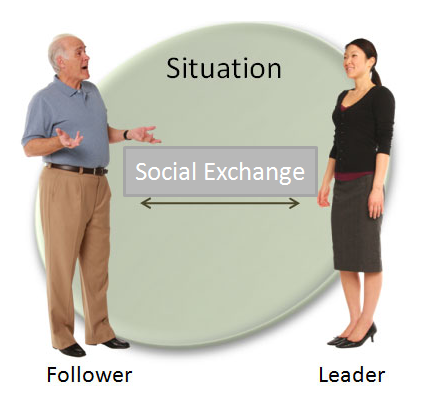Social Leadership

Social skills may be defined as being able to communicate and cooperate effectively within and across culturally diverse boundaries (organizational, geographical, demographic, professionally) – experimenting, innovating, connecting, sharing, learning together and supporting one another (Anne Marie Mcewan).
Social skills are one of the main tools for building high performance teams in that they help to build trust, respect, team spirit, and reduce conflict among the team members. This in turn creates an atmosphere of caring about each other.
5+2 Major Behavior Patterns of Leaders
Social Leadership is one of the 5+2 major behavior patterns of effective leaders. Together, Howell and Costley (2001) wrote the first five styles. Shortly after their work was published, Costley passed away. Howell then went on to list two new ones (King, 2001):
+5
-
Supportive Leader - Support and help with team member's development, show consideration, and is people oriented.
-
Directive Leader - Delegate tasks to new team members and use when a culture or situation prefers that the status be well defined.
-
Participative Leaders - Involve team members in decision making by using different approaches depending upon the situation; listen to disparate voices, and then create an alliance.
-
Reward and punishment leaders. Recognize and reward followers; provide punishment when required (normally in the form of counseling).
-
Charismatic Leaders - Have a strong effect on followers by appealing to their emotions, aspirations, needs, and values.
+2
-
Boundary Spanning Leader - Build networks for the team by representing the team with higher-ups and connecting them with other groups.
-
Social Leader - Build and forge social exchanges.
The authors note that these are not styles in which a leader normally operates out of one mode, but rather the leader fits one of the above seven styles to fit the situation and the characteristics of his or her team to achieve the best outcome. Thus, they are behavioral patterns that good leaders know how and when to operate out of.
The last two leadership behaviors, Boundary Spanning Leader and Social Leader, fall under what is known as distributed leadership, in that leadership is shared through the interactions or social exchanges of the leader, followers, and the situation. Thus, rather than being a directive or linear form that travels from the leader to the followers, it is a horizontal network composed of the entire team in which the leader uses feedback from all when faced with decisions.
This article focuses on the last one, Social Leadership. For information about other types of styles, see Leadership Styles and Transformational Leadership.
Social Exchanges
A social exchange is the exchange of activity, tangible or intangible, and more or less rewarding or costly, between at least two persons (Cook, Rice, 2001).

Each social exchange that a leader has with his or her followers may affect different behaviors and attitudes, thus multiple exchange relationships are needed both by the team members and their leader (Settoon, Bennett, Liden, 1996). Employees get different forms of resources and support from each social exchange, while organizations benefit from different and desired employee attitudes and behaviors.
Social Judgment Skills for Leaders
Besides the basic social skills that every person in the organization must understand, there are four primary social judgment skills that a good leader must learn (Northouse, 2007; Zaccaro, Mumford, Connelly, Marks, Gilbert, 2000):
-
Perspective Taking - Using empathy to understand other's attitudes towards goals, problem solving, solutions offered, and their points of view.
-
Social Perceptiveness - Having insight and awareness to how employees will react to organizational change by understanding what is important to them and what motivates them.
-
Behavior Flexibility - The ability to change and adapt one's behavior to situational changes by being flexible rather then locked in to one's impulses.
-
Social Performance - Understanding the employees' perspectives in order to communicate a vision. If there is resistance or conflict, be a mediator and/or coach, rather than a boss who gives orders.
Social Judgment skills can be increased by watching and reflecting on how others do it, increasing your listening skills, and using empathy.
Watching how other people do something and then learning from it is called modeling. It is one of the primary ways that people learn social skills. Reflecting on how people react to you and to others will help expand your understanding of the skill and help you to learn it more deeply.
When talking with others, be sure to listen to them rather than just hear them. In addition, listen for understanding, rather than be judgmental.
To empathize with them, heed the Sioux Indian Tribal Prayer,
“Great Spirit, help us never to judge another until we have walked for two weeks in his moccasins.”
Empathy differs from sympathy in that sympathy connotes spontaneous emotion rather than a conscious, reasoned response. For more information, see Motivation.
Social Interactions Trump Engagement Surveys
Although Gallup has been measuring employee engagement for about the last 25 years, it started gaining real traction in 1999, when Marcus Buckingham and Curt Coffman wrote their best selling book, First, Break All The Rules, which discusses the survey. What's really interesting is that over the last several years that employee engagement has been tracked, only about 30% of employees are engaged, while the rest are either not fully engaged or disengaged (Gallop, pdf). It would seem that with all these surveys taking place over a number of years, employee engagement would be rising, rather than staying the same.
The reason is that there are a couple of flaws in engagement surveys. The first is that it is hard to measure a concept that is not clearly defined:
Employee engagement is a concept with multiple definitions, arguably no form of direct measure, and bewildering crossover with other longer standing concepts (Dicke, 2007).
The second flaw is that emotions, which engagement falls under, is not a steady state. The majority of the surveys are given once a year. For example, I worked for a Fortune 500 company for several years and took several of the surveys (all spaced at least a year apart). On one of them I was not considered fully engaged because I marked one item down. If I had been given the survey a few days earlier or later, then I probably would not have marked it down. Rather than measuring engagement several times in a short period of time as good emotional surveys do, it rates a person at one point in time in a year.
In addition, the survey assumes that one minor distraction is going to be on a person's mind all day, every day of the year, which is normally not true.
Having social interactions numerous times a day with your team and providing good leadership will not only engage them, but will also give you a better pulse of the level of engagement than any survey could possible ever measure.
Social Media for the New Social Leader
Conte and Paolucci (2001) noted that a social interaction allows the team to update their knowledge base by adding to it, removing information from it, or modifying an existing representation. This allows them to perceive positive and/or negative effects of an event that another person has experienced. This is what makes social interactions so effective — it allows them to understand the state of the world through another person and then use the new information in the pursuit of their own goals.
In the past, social interactions were pretty much limited to a common environment, telephones, and letters:

However, with the addition of social medial tools, the common environment has been greatly extended:

Social media may thought of as communication tools that allows users to create, modify, and/or distribute content. And rather than being a broadcast model for one-to-many, such as a typical web page or phone call, social media are more of a many-to-many model that allows a conversational format for people to create, share, and remix information. Social media includes such tools as blogs, microblogs (e.g., Twitter and Yammer), file sharing (e.g., Flickr and SlideShare), Virtual Meeting Places, (e.g., Adobe Connect and Elluminate), social sites (e.g. Facebook and Google+), and wikis.
Social media allows us to have social interactions with others across time. Design guru John Thackara (2005) wrote that new technology normally works best when helping people to interact across time, rather than space. For example, it is helpful that I can communicate with others from almost any place in the world. But what makes them really invaluable is the ability to shift them to a time that best suits me.
For more information, see a similar concept — Social Learning.
Next Steps
Social Leadership Self-Assessment Questionnaire
Next chapter: Authentic Leadership and Social Influence
You can leave a comment on this article at my blog
References
Conte, R., Paolucci, M. (2001). Intelligent Social Learning. Journal of Artificial Societies and Social Simulation. vol. 4, no. 1.
Cook, K.S., Rice, E.R.W. (2001). Exchange and Power: Issues of Structure and Agency. In Handbook of Sociological Theory, ed. by Turner, J.H., p.699. New York: Springer Science+Business Media LLC.
Dicke, C. (2007). Employee Engagement: I Want It, What Is It?
Dicke, Holwerda, Kontakos, Stepp (eds). Employee Engagement: What Do We Really Know? What Do We Need to Know to Take Action? Paris, France: CAHRS. Retrieved from: http://www.uq.edu.au/vietnampdss/docs/July2011/EmployeeEngagementFinal.pdf
Howell, J.P., Costley D.L. (2001). Understanding Behaviours for Effective Leadership. NJ: Prentice-Hall.
King, J. (2001). NMSU professors say leaders are known by what they do. Retrived from: http://newscenter.nmsu.edu/4393/
Northouse, G. (2007). Leadership Theory and Practice. (3rd ed.) Thousand Oaks, CA: Sage Publications, Inc.
Settoon, R.P., Bennett, N., Liden, R.C. (1996). Social Exchange in Organizations: Perceived Organizational Support, Leader-Member Exchange, and Employee Reciprocity. Journal of Applied Psychology, Vol. 81, No. 3, pp. 219-227.
Thackara, John (2005). In The Bubble: Designing in a Complex World. Cambridge, Massachusetts: MIT Press World.
Wilkinson, D. (2007). Distributed Leadership Briefing Paper. Leeds: Northern Leadership Academy.
Zaccaro, S.J., Mumford, M.D., Connelly, M.S., Marks, M.A., Gilbert, J.A. (2000). Assessment of Leader Problem-Solving Capabilities. Leadership Quarterly, 11(1), p.p. 37-64.
